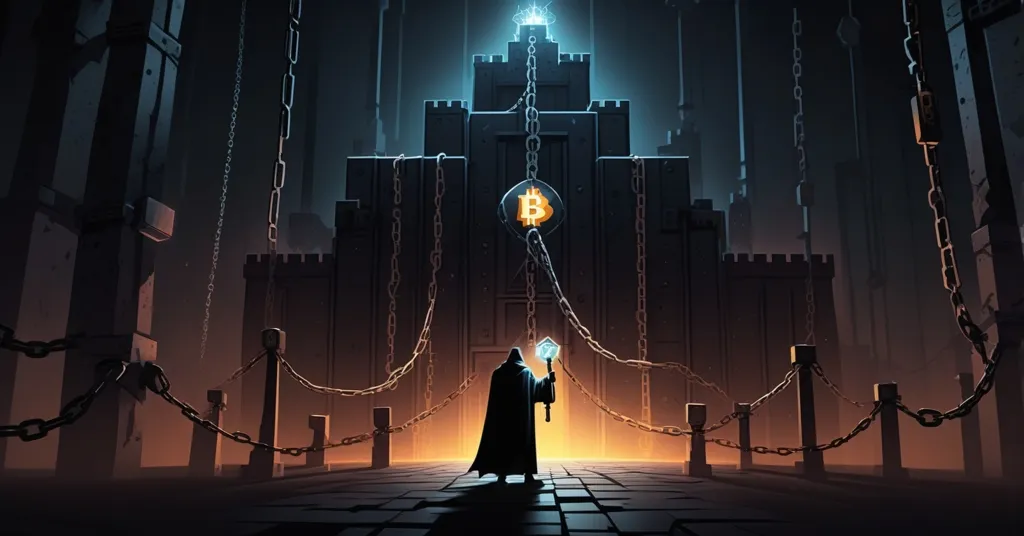Bybit Exposes 16 Blockchains with Fund-Freezing Powers, Challenging Crypto Decentralization

Crypto Kill Switch Shock: Bybit Reveals 16 Blockchains That Can Freeze Funds, Threatening Decentralization
Brace yourselves, crypto warriors—Bybit has just unleashed a report that’s sending shockwaves through the blockchain space. Their Lazarus Security Lab has exposed 16 blockchain networks, including giants like BNB Chain and Aptos, with built-in mechanisms to freeze user funds or halt transactions. This isn’t just a technical quirk; it’s a direct challenge to the core principle of decentralization that crypto was built on.
- Bybit’s Explosive Finding: 16 blockchains out of 166 analyzed have fund-freezing capabilities.
- Major Players Involved: BNB Chain, Aptos, VeChain, and others possess these control mechanisms.
- Transparency Demand: Bybit insists networks must openly disclose these powers to protect user trust.
Bybit’s Findings: The 16 Culprits
The report from Bybit’s research arm, Lazarus Security Lab, isn’t some obscure white paper—it’s a red alert for anyone who believes their crypto is beyond interference. After scrutinizing 166 blockchain networks, they pinpointed 16 with mechanisms allowing developers, validators, or foundations to lock down funds or block transactions at their discretion. We’re not talking about fringe projects; these are heavyweights with massive adoption and billions in value. The list includes BNB Chain (backed by Binance), Aptos, VeChain (known for supply chain solutions), Chiliz (a leader in sports and entertainment tokens), Viction, XinFin’s XDC Network, EOS, Sui, Heco Chain (linked to Huobi), and several others. For users on these networks, the reality is stark: your funds might not be as untouchable as you think.
How Kill Switches Work
So, how exactly do these crypto kill switches operate? Bybit categorizes them into three unsettling types, each more concerning than the last. First, ten of these networks use configuration files—think of these as settings documents like YAML or ENV files, editable by a select few validators or centralized entities. These files often contain private blacklists that can flag and freeze specific addresses or transactions without public oversight. Second, five networks, including BNB Chain, have hardcoded freezing features built directly into their source code—permanent rules embedded in the blockchain’s foundation, not easily altered or removed. Finally, Heco Chain stands out with a smart contract-based blacklist, meaning the freezing mechanism is executed through on-chain code, still controlled by a central authority. If that doesn’t remind you of a traditional bank locking your account, what does?
The implications are chilling. Imagine a scenario where BNB Chain detects a suspected hack—funds could be frozen indefinitely while they investigate. But who decides what’s “suspicious,” and how long does the freeze last? Without transparent rules, users are at the mercy of opaque decision-makers, a far cry from the permissionless ethos of blockchain technology. For deeper insights into this issue, check out the detailed findings in this report on blockchain fund-freezing mechanisms.
The Next 19: Looming Risks in the Cosmos and Beyond
As if 16 networks weren’t enough to worry about, Bybit also flagged 19 additional blockchains as having the potential to implement similar controls with minimal changes to their protocols. Many of these fall within the Cosmos ecosystem, a network of interoperable blockchains. The report highlights Cosmos’ “module accounts”—special system accounts designed for specific functions—that could, in theory, be tweaked to restrict user access or freeze funds. As Bybit’s researchers noted,
“This function could, in theory, be modified in the future to add a hacker’s address.”
Translation: even networks currently free of kill switches might not stay that way, especially under pressure from regulators or security incidents. This looming risk adds another layer of uncertainty for users betting on altcoin innovation.
The Case for Kill Switches: Security or Control?
Before we torch these networks entirely, let’s unpack why such mechanisms exist. Supporters argue they’re a necessary evil for blockchain security. With hacks, scams, and illicit activities like money laundering rampant in the crypto space, freezing capabilities can act as an emergency brake to limit damage. Bybit itself has firsthand experience—earlier this year, they endured a staggering $1.5 billion cold wallet hack. Through coordinated efforts with partners like Circle (issuer of USDC), Tether (behind USDT), THORchain, and Bitget, they froze $42.9 million of stolen funds. An additional $43 million was recovered via mETH Protocol. On paper, that’s a victory—millions saved that might have vanished into the digital abyss.
But here’s the rub: this recovery wasn’t a decentralized miracle. It was a top-down intervention, orchestrated by centralized entities with the power to override user control. Circle and Tether, for instance, have a track record of freezing assets under regulatory pressure, not community consensus. While the outcome benefited Bybit, it exposed how much power still rests in the hands of a few, echoing the very systems crypto was meant to disrupt. If validators or stablecoin issuers can play god with your funds, are you really in control?
Threats to Decentralization: A Philosophical Gut Punch
This isn’t just a technical glitch; it’s a betrayal of crypto’s founding vision. Blockchain technology, pioneered by Bitcoin, promised a world where no one—governments, banks, or developers—could interfere with your money. Yet, these kill switches hand centralized players the ability to censor transactions or seize assets, undermining the censorship resistance that makes crypto revolutionary. As Bybit’s researchers aptly put it,
“The existence of fund-freezing functions, even when implemented for security purposes, challenges the notion of full decentralization.”
The risks aren’t theoretical. If a network can freeze funds to stop a hacker, it can just as easily do so under regulatory duress. Look at precedents like the U.S. Treasury’s OFAC sanctions on Tornado Cash addresses, where transactions were blacklisted to comply with government mandates. Networks with built-in kill switches are ripe for such exploitation, potentially bending to court orders or sanction lists. For those of us rooting for financial freedom and effective accelerationism, this is a brutal reminder that the battle against centralized control is nowhere near over.
Worse, it erodes trust. Users dive into crypto for autonomy and privacy, not to have their assets locked by some shadowy validator over a vague “security concern.” Imagine logging into your wallet after a market crash, desperate to move funds, only to find them frozen by a network you trusted—not because of your actions, but due to an arbitrary policy. That’s the harsh reality for users on these 16 blockchains, and it’s a slap in the face to the ethos of self-sovereignty.
Bitcoin’s Fortress: A Stark Contrast
For Bitcoin maximalists, this report is both a vindication and a call to vigilance. Bitcoin’s design stands as a fortress of true decentralization—no kill switches, no centralized overrides. Its Proof of Work consensus mechanism and vast network of independent nodes ensure that no single entity can tamper with transactions or freeze funds. If you hold your BTC in a non-custodial wallet, it’s yours, period. No validator, no foundation, no government can touch it without your private key. Compare that to the altcoin ecosystem, where innovation often comes at the cost of ideological purity, and the difference is night and day.
That said, let’s not dismiss altcoins outright. Networks like Ethereum drive smart contract innovation, while Cosmos pushes interoperability—niches Bitcoin doesn’t (and perhaps shouldn’t) fill. These ecosystems expand crypto’s utility, but Bybit’s findings highlight the trade-offs. Users must weigh whether the bells and whistles of altcoins are worth the risk of centralized control. For core holdings, Bitcoin remains the unassailable standard, a reminder of what crypto can and should be.
What’s Next for Crypto?
Bybit’s report isn’t just an exposé; it’s a rallying cry. Transparency is the bare minimum—networks with fund-freezing powers must disclose them upfront, no excuses. As their researchers demand,
“Blockchains that include freezing capabilities should disclose them clearly.”
Users shouldn’t have to dig through white papers or GitHub repos to learn their funds are at risk of being locked. Beyond that, the community must confront a deeper question: is security worth sacrificing decentralization? Bitcoin proves you can resist censorship without kill switches; maybe it’s time other networks stop taking shortcuts and start taking notes.
For everyday users, there are practical steps to navigate this mess. Research a blockchain’s governance model before investing—does it have centralized controls? Are its rules transparent? Prioritize networks with immutable designs like Bitcoin for your core holdings, and approach altcoins with eyes wide open. The fight for financial freedom means staying informed and skeptical, especially when “safety” starts looking like a shinier cage.
Key Takeaways and Questions
- Which Blockchains Can Freeze User Funds?
Bybit’s research names 16 networks with these mechanisms, including BNB Chain, Aptos, VeChain, Chiliz, Viction, XinFin’s XDC Network, EOS, Sui, and Heco Chain, all capable of restricting transactions or locking assets through various methods. - Why Do These Kill Switches Exist?
They’re often justified as security tools to combat hacks, fraud, and illicit activities, as evidenced by Bybit recovering millions post-hack with assistance from Circle and Tether. - How Do These Mechanisms Threaten Decentralization?
They grant centralized entities—validators, developers, or foundations—power to block transactions or seize funds, directly contradicting the permissionless, censorship-resistant nature of blockchain tech. - Is Bitcoin Vulnerable to Fund Freezing Like These Networks?
No, Bitcoin’s immutable design and decentralized consensus via Proof of Work prevent any single party from freezing funds, making it a bastion of true user control. - How Do Kill Switches Impact Crypto Adoption?
They risk eroding trust among users seeking autonomy, potentially slowing mainstream adoption if networks prioritize control over freedom, especially under regulatory pressure. - What Should Users Demand From Blockchain Networks?
Full, upfront disclosure of any fund-freezing capabilities is critical, ensuring users aren’t misled about the level of control they have over their assets.
Let’s cut through the noise: this isn’t a minor bug; it’s a fundamental clash of values. As we push to disrupt the financial status quo and drive mass adoption, we can’t let the mirage of “safety” dismantle what makes crypto powerful. Bitcoin lights the way, but the broader ecosystem—flaws and all—must decide whether it’s building for liberation or just a fancier form of control. No bullshit, no compromises. The future of money hangs in the balance, and the choice is ours to make.



